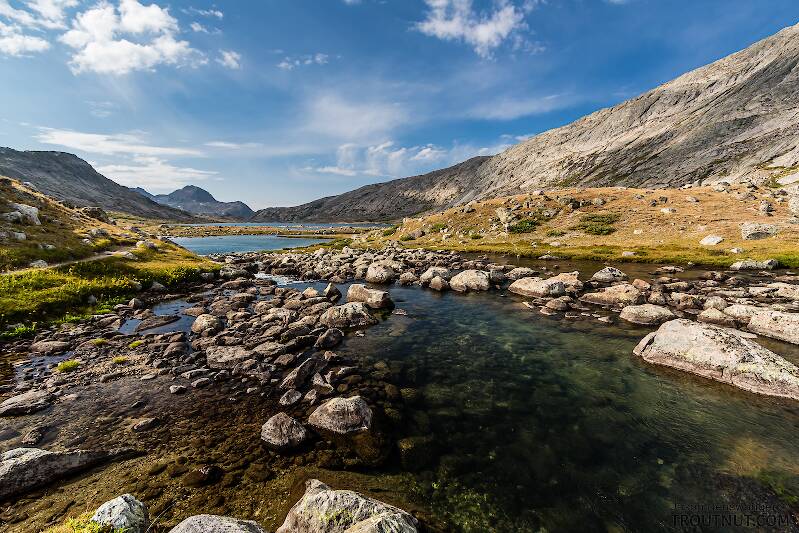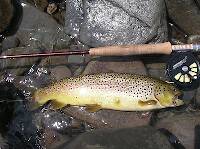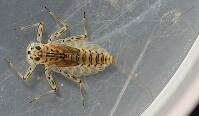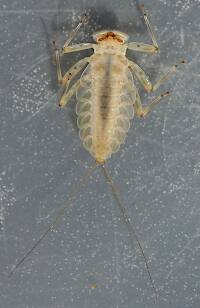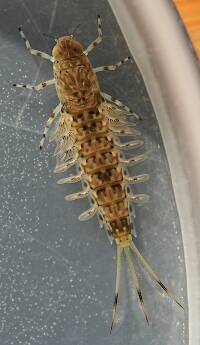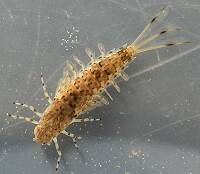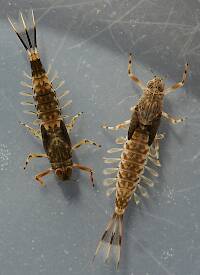
Salmonflies
Pteronarcys californica
The giant Salmonflies of the Western mountains are legendary for their proclivity to elicit consistent dry-fly action and ferocious strikes.
Featured on the forum
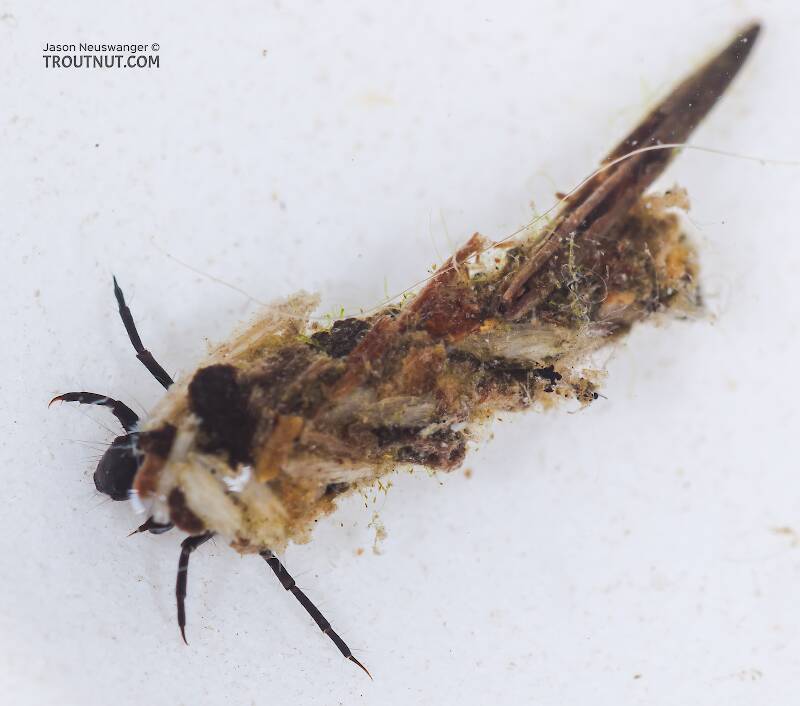
This seems to be a young larva of Limnephilus. Although not clear in the picture, several ventral abdominal segments have chloride epithelia.

Troutnut is a project started in 2003 by salmonid ecologist Jason "Troutnut" Neuswanger to help anglers and
fly tyers unabashedly embrace the entomological side of the sport. Learn more about Troutnut or
support the project for an enhanced experience here.
Flyhatch on Jan 23, 2008January 23rd, 2008, 2:31 am EST
Hello everyone! First off...this is a great website. Full of awesome info and great knowledge.
I am wondering if anyone can edjucate me in regards to a local stream which I fish about the bugs. This northeastern trout stream is small, usually flowing between 20 and 80 cfs. It has awesome boulder and rock composition combined with a continuous gradient which gives it awesome character. When the water is in the middle range, it is impossible to fish quickly as it has lie after lie with the current and boulder structure. We do have a few pools and glides, however it is mainly broken water and seams.
We have great stoneflies...big ones too! These stoneflies can range up to 1.5" in length which is great for such a small stream (between 10-15' wide in most places.) The mayflies are another story! We do have our in season, LIGHT hatches, however with quality of water like we have, one would think that we would have rocks teeming with mayfly nymphs and hatches.
If anyone can give me a quick thought or too as to why we have great stoneflies but not nearly the mayfly content...that would be great.
Thanks!
I am wondering if anyone can edjucate me in regards to a local stream which I fish about the bugs. This northeastern trout stream is small, usually flowing between 20 and 80 cfs. It has awesome boulder and rock composition combined with a continuous gradient which gives it awesome character. When the water is in the middle range, it is impossible to fish quickly as it has lie after lie with the current and boulder structure. We do have a few pools and glides, however it is mainly broken water and seams.
We have great stoneflies...big ones too! These stoneflies can range up to 1.5" in length which is great for such a small stream (between 10-15' wide in most places.) The mayflies are another story! We do have our in season, LIGHT hatches, however with quality of water like we have, one would think that we would have rocks teeming with mayfly nymphs and hatches.
If anyone can give me a quick thought or too as to why we have great stoneflies but not nearly the mayfly content...that would be great.
Thanks!
Wbranch on Jan 23, 2008January 23rd, 2008, 3:05 am EST
Flyhatch,
You wouldn't be referring to the Big Flatbrook are you? If you are that used to be my home water way back in the early 1960's until 1984.
Even back in 1961 there were very few mayflies ever present on this beautiful little creek. I asked some of the old codgers (now I'm an even older codger) why there were so few mayflies and the answer was that back in the 1950's, before the detrimental effects on flora and fauna were known, DDT was extensively sprayed all up and down the valley that Flatbrook flows through. I'm assuming it was sprayed to kill mosquitoes but it also killed virtually all of the other aquatic insects in that stream except for the caddis that construct their cases with little sticks and pebbles.
To tell you the truth I don't ever remember seeing a real hatch on the stream. Once in awhile the trout would rise but there would only be a handful of insects.
You wouldn't be referring to the Big Flatbrook are you? If you are that used to be my home water way back in the early 1960's until 1984.
Even back in 1961 there were very few mayflies ever present on this beautiful little creek. I asked some of the old codgers (now I'm an even older codger) why there were so few mayflies and the answer was that back in the 1950's, before the detrimental effects on flora and fauna were known, DDT was extensively sprayed all up and down the valley that Flatbrook flows through. I'm assuming it was sprayed to kill mosquitoes but it also killed virtually all of the other aquatic insects in that stream except for the caddis that construct their cases with little sticks and pebbles.
To tell you the truth I don't ever remember seeing a real hatch on the stream. Once in awhile the trout would rise but there would only be a handful of insects.
Catskill fly fisher for fifty-five years.
Softhackle on Jan 23, 2008January 23rd, 2008, 6:58 am EST
Hi,
Wbranch's reply might be right on the money, because the residual effects of DDT are still being felt, today, although things seem to be getting a little better.
You can bet, however, that something in the water is either not present or present that is preventing the mayflies from being there. They are more delicate that stone flies or caddis. It could be something as simple as a low or neutral PH, which would cut back on the insect population. Other things factor in as well--dissolved oxygen, plant life, sediment, polution, etc.
There is probably a government agency in your state/local area that works on, has knowledge of, or regularly tests and regulates surface waters. Perhaps a check with them regarding your stream would shed more light on the subject for you.
Keep us posted on your progress.
Mark
Wbranch's reply might be right on the money, because the residual effects of DDT are still being felt, today, although things seem to be getting a little better.
You can bet, however, that something in the water is either not present or present that is preventing the mayflies from being there. They are more delicate that stone flies or caddis. It could be something as simple as a low or neutral PH, which would cut back on the insect population. Other things factor in as well--dissolved oxygen, plant life, sediment, polution, etc.
There is probably a government agency in your state/local area that works on, has knowledge of, or regularly tests and regulates surface waters. Perhaps a check with them regarding your stream would shed more light on the subject for you.
Keep us posted on your progress.
Mark
"I have the highest respect for the skilled wet-fly fisherman, as he has mastered an art of very great difficulty." Edward R. Hewitt
Flymphs, Soft-hackles and Spiders: http://www.troutnut.com/libstudio/FS&S/index.html
Flymphs, Soft-hackles and Spiders: http://www.troutnut.com/libstudio/FS&S/index.html
Troutnut on Jan 23, 2008January 23rd, 2008, 4:12 pm EST
It just sounds like really good stonefly habitat to me. There aren't many really prolific Eastern mayflies that thrive in extremely fast, bouldery stuff. Most of the Heptageniids, which do well in that setting, have sparse, drawn-out hatches.
Also, many stonefly nymphs eat mayfly nymphs. Depending on the species present, they might effectively keep the mayfly population low.
One of the best things you could do to answer this question is kick around with a fine-meshed bug net or seine to see what nymphs are there. That'll give you a better idea what's really in the river than trying to judge based on hatching adults.
There may be some chemical toxin at work, too, but I don't know anything about that. So I'm just going at it from the amateur entomologist / ecologist-in-training viewpoint. :)
Also, many stonefly nymphs eat mayfly nymphs. Depending on the species present, they might effectively keep the mayfly population low.
One of the best things you could do to answer this question is kick around with a fine-meshed bug net or seine to see what nymphs are there. That'll give you a better idea what's really in the river than trying to judge based on hatching adults.
There may be some chemical toxin at work, too, but I don't know anything about that. So I'm just going at it from the amateur entomologist / ecologist-in-training viewpoint. :)
Jason Neuswanger, Ph.D.
Troutnut and salmonid ecologist
Troutnut and salmonid ecologist
Konchu on Jan 26, 2008January 26th, 2008, 5:40 am EST
I think troutnut posted a good response.
Several of my local streams that almost certainly never have been victim to pesticide pollution have many more stoneflies, including some big ones, than any-sized mayflies. For example, I did some collecting with a colleague two weeks ago today, and we found maybe one mayfly specimen all day, but lots and lots of stoneflies, including adults in the riparian zone (on land immediately by the stream).
Part of the reason that we found more stoneflies than mayflies is the time of year that we looked. The same might be the case for the stream in question. Streams have natural ecological cycles when certain fauna are more obvious at certain times. I say this because the majority of the stuff is there the majority of the time, but we might not see it because it is too small or in a stage that we don't recognize (e.g., eggs) or living in the interstitial zone (between rocks and soil particles in the stream bed), where we just wouldn't see it unless you dug down and went to a whole lot of specialized effort.
Several of my local streams that almost certainly never have been victim to pesticide pollution have many more stoneflies, including some big ones, than any-sized mayflies. For example, I did some collecting with a colleague two weeks ago today, and we found maybe one mayfly specimen all day, but lots and lots of stoneflies, including adults in the riparian zone (on land immediately by the stream).
Part of the reason that we found more stoneflies than mayflies is the time of year that we looked. The same might be the case for the stream in question. Streams have natural ecological cycles when certain fauna are more obvious at certain times. I say this because the majority of the stuff is there the majority of the time, but we might not see it because it is too small or in a stage that we don't recognize (e.g., eggs) or living in the interstitial zone (between rocks and soil particles in the stream bed), where we just wouldn't see it unless you dug down and went to a whole lot of specialized effort.
Quick Reply
Related Discussions
Topic
Replies
Last Reply
Re: Amazon.com ship dates for new edition of Ernest Schwiebert's Nymphs
In General Discussion by Troutnut
In General Discussion by Troutnut
2
Jun 15, 2007
by Taxon
by Taxon
6
Jun 4, 2016
by Creno
by Creno
Re: Nice pictures of accompanying Epoicocladius sp. larvae
In Ephemera simulans Mayfly Nymph by Beardius
In Ephemera simulans Mayfly Nymph by Beardius
3
Aug 8, 2008
by Beardius
by Beardius
Re: Differentiation b/t Gomphidae and Cordulegastridae
In the Insect Order Odonata-Anisoptera by DMM
In the Insect Order Odonata-Anisoptera by DMM
1
Nov 29, 2006
by Troutnut
by Troutnut
1
Aug 30, 2010
by GONZO
by GONZO

